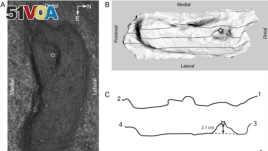02 May, 2019
Researchers in Chile say they discovered a human footprint they believe is the oldest ever found in the Americas.
Scientists involved in the fossil discovery said the footprint dates back at least 15,600 years. Their results are reported in a study published in the scientific journal PLOS One.
The footprint was discovered in 2011 at the Pilauco excavation site in the city of Osorno. A student from Chile's Austral University found the footprint. Scientists worked for years to confirm whether the print could have come from a human species.
Mario Pino is a professor and geologist at Austral University's Institute of Earth Sciences. He helped examine the fossil. He said carbon dating methods were used to link the footprint to the same time period as plant material found in the area.

The ancient human footprint discovered from the Pilauco archaeological site, in northern Patagonia, Chile, is believed to be at least 15,600 years old. (PLOS One)
Pino said his team used the print to estimate the general size, shape and structure of the human foot. Researchers believe it belonged to a barefoot man who weighed about 70 kilograms.
Karen Moreno is also with Austral University and a lead researcher on the project. She said the print showed evidence of clearly formed toes and a ball at the back of the foot. This would be "consistent with what would happen to (a human) who tries to walk in the mud," Moreno said.
Pino said the man likely belonged to a species called Hominipes modernus, which is related to Homo sapiens. Homo sapiens is the species of human that exists today.
Moreno said the latest find provides some of the oldest evidence of humans in the Americas. "Little by little in South America, we're starting to find sites with evidence of human presence," she said. "But this is this oldest in the Americas."
The study states that the same area in Chile has also produced fossils providing information on other animals, including early elephants and an ancestor of American horses. The digging teams have also found evidence of invertebrates, as well as different forms of ancient plant life and wood material.
Moreno said the researchers also found stone artifacts within the same layers of soil as the footprint. This, she believes, could provide more evidence to support a theory that human settlements existed in the Americas well before a group known as the "Clovis" hunters.
The Clovis group was a prehistoric culture that many scientists believed were the first to arrive in North America -- about 13,000 years ago.
But some scientists have suggested that artifacts discovered in recent years suggest other humans might have arrived in the Americas about 1,500 years earlier.
I'm Bryan Lynn.
Bryan Lynn wrote this story for VOA Learning English based on reports from Reuters, Agence France Press and online sources. Ashley Thompson was the editor.
We want to hear from you. Write to us in the Comments section, and visit 51VOA.COM.
_____________________________________________________________
Words in This Story
fossil – n. part of an animal or plant from thousands of years ago, preserved in rock
excavation – n. the act of digging in the ground to look for objects from the past
barefoot – adj. not wearing shoes or other feet coverings
consistent – adj. always behaving or happening in a similar way
mud – n. a thick liquid mixture of soil and water
artifact – n. a simple object made by people in the past
prehistoric – adj. relating to the time before people could write
glacier – n. very large area of ice that moves slowly down a slope or valley or over a wide area of land